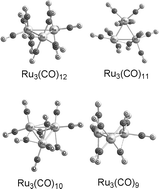For the saturated carbonyl trimer Ru3(CO)12 theoretical methods predict a doubly bridged Ru3(CO)10(μ-CO)2 structure to lie only 0.3 kcal mol−1 above the unbridged global minimum in accord with the fluxional properties observed experimentally by carbon-13 NMR on the very stable unbridged Ru3(CO)12. For M3(CO)11 and M3(CO)10 the global minima for the Fe, Ru, and Os derivatives each have totally different arrangements of the carbonyl groups. Thus the global minimum of Ru3(CO)11 is singly edge-semibridged Ru3(CO)10(μ-CO) in contrast to the doubly face-bridged Fe3(CO)9(μ3-CO)2 and triply edge-bridged Os3(CO)8(μ-CO)3 found as global minima for the iron and osmium analogues, respectively. Furthermore, comparison of our predicted ν(CO) frequencies for low-lying unbridged, singly bridged, and doubly bridged isomers of Ru3(CO)11 with the 1987 experiments of Bentsen and Wrighton indicates that three different Ru3(CO)11 isomers are generated in these low-temperature inert matrix Ru3(CO)12 photolysis experiments depending on the conditions. For Ru3(CO)10 the global minimum is a triply bridged structure Ru3(CO)7(μ-CO)3, which is very different from the Fe3(CO)9(μ3-CO) and Os3(CO)8(μ3-CO)(μ-CO) global minima found for the iron and osmium analogues, respectively. For Ru3(CO)9 the global minimum is a singly bridged structure Ru3(CO)8(μ-CO) analogous to the global minimum for the osmium analogue but totally different from the triply bridged global minimum of Fe3(CO)9.

You have access to this article
 Please wait while we load your content...
Something went wrong. Try again?
Please wait while we load your content...
Something went wrong. Try again?


 Please wait while we load your content...
Please wait while we load your content...